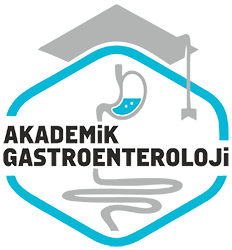Aralik 2020
Kronik hepatit C tedavisinde ikinci kusak direk etkili oral antivirallerin gerçek yaşam verileri: Tek merkez ve heterojen hasta grubu
Real life data of second generation direct acting oral antivirals in the treatment of chronic hepatitis C: A single center and heterogeneous patient group
- Ana Sayfa
- Sayılar
- Aralik 2020
- Kronik hepatit C tedavisinde ikinci kusak direk etkili oral antivirallerin gerçek yaşam verileri: Tek merkez ve heterojen hasta grubu...
Namik Kemal Üniversitesi, Tip Fakültesi, 2Gastroenteroloji Bilim Dali, Tekirdag
Özet
Giriş ve Amaç: Kronik hepatit C enfeksiyonu karaciger sirozu ve hepatoselüler karsinomun nedenleri arasındadir. Bu çalışmada primer olarakkronik hepatit C’li heterojen bir hasta grubunda güncel olarak kullanılanikinci kusak direk etkili oral antivirallerin tedavi etkinligi ve yan etki profillerinin arastirilmasi amaçlanmıştır. Gereç ve Yöntem: Retrospektifolan bu çalışmaya ikinci kusak direk etkili oral antiviral tedavi alan 72hasta dahil edilmıştır. Hastalara ait klinik ve laboratuvar verileri polikliniktakip dosyalarindan elde edilmıştır. Bulgular: Hastaların yaş ortalaması 58±14 olup, 39’u (%54) kadın idi. Baskin genotip 1b idi (%74.6).Non-sirotik, kompanse siroz ve dekompanse siroz Hastaların sayılari si-rasiyla; 56 (%77.8), 14 (%19.4) ve 2 (%2.8) idi. On sekiz hasta (%25)tedavi deneyimli idi. Paritaprevir/ritonavir/ombitasvir + dasabuvir, ledipasvir/sofosbuvir, ledipasvir/sofosbuvir + ribavirin, sofosbuvir + ribavirin, glekaprevir + pibrentasvir ve paritaprevir/ritonavir/ombitasvir +ribavirin alan hasta sayılari sırasıyla; 38 (%52.8), 13 (%18.1), 7 (%9.7),7 (%9.7), 6 (%8.3) ve 1 (%1.4) idi. Toplam 71 hasta tedaviyi tamamladive bunlarin 69’unda (%97.2) kalici viral yanit elde edildi. Ayrıca baslangiç aspartat aminotransferaz, alanin amimotransferaz, gama glutamiltransferaz ve alfa fetoprotein düzeylerinde tedavi ile birlikte anlamli birdüşüş izlendi (p <0.05). Bilirübin düzeyleri ise tedavi esnasinda anlamlibir şekilde yükselmekle beraber (p <0.05), tedavinin sona ermesiyle birlikte düşüş göstermekteydi. Yan etki profilleri açısından, kullanılan tümrejimlerde gözlenen yan etkiler hafif şiddette olup, tedaviyi kesecek vasifta degildi. Sonuç: Ülkemizde kronik hepatit C infeksiyonunda güncelolarak kullanılan ikinci kusak direk etkili oral antiviraller yüksek etkinlikve düşük yan etki profiline sahiptirler
Abstract
Background and Aims: Chronic hepatitis C infection is one of the causes of liver cirrhosis and hepatocellular carcinoma. The purpose of thisstudy was primarily to examine the treatment efficacy and side effectprofiles of second-generation direct-acting oral antivirals currently usedin a heterogeneous patient group with chronic hepatitis C. Materialsand Methods: This retrospective study included 72 patients who received second-generation direct-acting oral antiviral therapy. Clinical andlaboratory data of the patients were collected from outpatient follow-upfiles. Results: The mean age of the patients was 58±14 years, of which39 (54%) were women. The predominant genotype was 1b (74.6%).Patients with no cirrhosis, compensated cirrhosis, and decompensatedcirrhosis were 56 (77.8%), 14 (19.4%), and 2 (2.8%), respectively. Eighteen patients (25%) were treatment experienced. On the other hand,patients treated with paritaprevir/ritonavir/ombitasvir + dasabuvir, ledipasvir/sofosbuvir, ledipasvir/sofosbuvir + ribavirin, sofosbuvir + ribavirin,glecaprevir + pibrentasvir, and paritaprevir/ritonavir/ombitasvir + ribavirin were 38 (52.8%), 13 (18.1%), 7 (9.7%), 7 (9.7%), 6 (8.3%), and 1(1.4%), respectively. A total of 71 patients completed the treatment and69 of them (97.2%) was obtained sustained viral response. In addition,a significant decrease was observed in the initial aspartate aminotransferase, alanine aminotransferase, gamma glutamyl transferase, and alpha fetoprotein levels during treatment (p <0.05). Although bilirubinlevels increased significantly during treatment (p <0.05), they decreasedat the end of treatment. In terms of the side effect profile, side effectsobserved in all regimes were mild and not severe enough to discontinuetreatment. Conclusion: Therefore, the second-generation direct-actingoral antivirals widely used in chronic hepatitis C infection in our countryhave high efficacy and low side effect profile.



